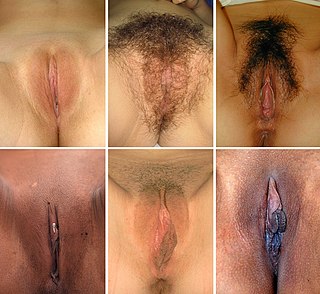
In mammals, the vagina is the elastic, muscular part of the female genital tract. In humans, it extends from the vulva to the cervix. The outer vaginal opening is normally partly covered by a thin layer of mucosal tissue called the hymen. At the deep end, the cervix bulges into the vagina. The vagina allows for sexual intercourse and birth. It also channels menstrual flow (menses), which occurs in humans and closely related primates as part of the monthly menstrual cycle.

The terms genital modification and genital mutilation can refer to permanent or temporary changes to human sex organs. Some forms of genital alteration are performed on adults with their informed consent at their own behest, usually for aesthetic reasons or to enhance stimulation. However, other forms are performed on people who do not give informed consent, including infants or children. Any of these procedures may be considered modifications or mutilations in different cultural contexts and by different groups of people.

The hymen is a thin piece of mucosal tissue that surrounds or partially covers the external vaginal opening. It forms part of the vulva, or external genitalia, and is similar in structure to the vagina.

Virginity is the state of a person who has never engaged in sexual intercourse. The term virgin originally only referred to sexually inexperienced women, but has evolved to encompass a range of definitions, as found in traditional, modern and ethical concepts. Heterosexual individuals may or may not consider loss of virginity to occur only through penile-vaginal penetration, while people of other sexual orientations often include oral sex, anal sex, or mutual masturbation in their definitions of losing one's virginity.
Annulment is a legal procedure within secular and religious legal systems for declaring a marriage null and void. Unlike divorce, it is usually retroactive, meaning that an annulled marriage is considered to be invalid from the beginning almost as if it had never taken place. In legal terminology, an annulment makes a void marriage or a voidable marriage null.

In many traditions and statutes of civil or religious law, the consummation of a marriage, often called simply consummation, is the first act of sexual intercourse between two people, either following their marriage to each other or after a short or prolonged romantic/sexual attraction. The definition of consummation usually refers to penile-vaginal sexual penetration, but some religious doctrines hold that there is an additional requirement that no contraception must be used.

Vaginoplasty is any surgical procedure that results in the construction or reconstruction of the vagina. It is a type of genitoplasty. Pelvic organ prolapse is often treated with one or more surgeries to repair the vagina. Sometimes a vaginoplasty is needed following the treatment or removal of malignant growths or abscesses in order to restore a normal vaginal structure and function. Surgery to the vagina is done to correct congenital defects to the vagina, urethra and rectum. It will correct protrusion of the urinary bladder into the vagina (cystocele) and protrusion of the rectum (rectocele) into the vagina. Often, a vaginoplasty is performed to repair the vagina and its attached structures due to trauma or injury. Labiaplasty, which alters the appearance of the vulva, can be performed as a discrete surgery, or as a subordinate procedure within a vaginoplasty.

In Islam, marriage is a legal contract between two people. Both the groom and the bride are to consent to the marriage of their own free wills. A formal, binding contract – verbal or on paper – is considered integral to a religiously valid Islamic marriage, and outlines the rights and responsibilities of the groom and bride. Divorce in Islam can take a variety of forms, some executed by a husband personally and some executed by a religious court on behalf of a plaintiff wife who is successful in her legal divorce petition for valid cause.
An imperforate hymen is a congenital disorder where a hymen without an opening completely obstructs the vagina. It is caused by a failure of the hymen to perforate during fetal development. It is most often diagnosed in adolescent girls when menstrual blood accumulates in the vagina and sometimes also in the uterus. It is treated by surgical incision of the hymen.

In the Catholic Church, a consecrated virgin is a woman who has been consecrated by the church to a life of perpetual virginity as a bride of Christ. Consecrated virgins are consecrated by the diocesan bishop according to the approved liturgical rite. The consecrated virgins are to spend their time in works of penance and mercy, in apostolic activity and in prayer, according to their state of life and spiritual gifts. A consecrated virgin may live either as a nun in some of the monastic orders or "in the world" under the authority of her bishop, to the service of the church.
Nāmūs is the Arabic word of a concept of an ethical category, a virtue, in Middle Eastern patriarchal character. Literally translated as "virtue", it is now more popularly used in a strong gender-specific context of relations within a family described in terms of honor, attention, respect/respectability, and modesty.
Hymenorrhaphy or hymen reconstruction surgery is the temporary surgical restoration of the hymen. The term comes from the Greek words hymen meaning "membrane", and raphḗ meaning "suture". It is also known as hymenoplasty, although strictly this term would also include hymenotomy.
A virginity test is the practice and process of determining whether a girl or woman is a virgin; i.e., to determine that she has never engaged in, or been subjected to, sexual intercourse. The test typically involves a check for the presence of an intact hymen, on the flawed assumption that it can only be torn as a result of sexual intercourse.
An artificial hymen is a type of prosthetic created for the purpose of simulating an intact human hymen, usually to fake virginity.

The vulva consists of the external female sex organs. The vulva includes the mons pubis, labia majora, labia minora, clitoris, vestibular bulbs, vulval vestibule, urinary meatus, the vaginal opening, hymen, and Bartholin's and Skene's vestibular glands. The urinary meatus is also included as it opens into the vulval vestibule. Other features of the vulva include the pudendal cleft, sebaceous glands, the urogenital triangle, and pubic hair. The vulva includes the entrance to the vagina, which leads to the uterus, and provides a double layer of protection for this by the folds of the outer and inner labia. Pelvic floor muscles support the structures of the vulva. Other muscles of the urogenital triangle also give support.
Postcoital bleeding is bleeding from the vagina in women after sexual intercourse and may or may not be associated with pain. The bleeding can be from the uterus, cervix, vagina and other tissue or organs located near the vagina. Postcoital bleeding can be one of the first indications of cervical cancer. There are other reasons why a woman may bleed after intercourse. Some women will bleed after intercourse for the first time but others will not. The hymen may bleed if it is stretched since it is thin tissue. Other activities may have an effect on the vagina such as sports and tampon use. Postcoital bleeding may stop without treatment. In some instances, postcoital bleeding may resemble menstrual irregularities. Postcoital bleeding may occur throughout pregnancy. The presence of cervical polyps may result in postcoital bleeding during pregnancy because the tissue of the polyps is more easily damaged. Postcoital bleeding can be due to trauma after consensual and non-consensual sexual intercourse.

A virginity auction is an auction, often publicized online, where a person seeks to sell their virginity. The winning bidder will win the right to be the first to have intercourse with the person.
The husband stitch or husband's stitch, also known as the daddy stitch, husband's knot and vaginal tuck, is a surgical procedure in which one or more sutures than necessary are used to repair a woman's perineum after it has been torn or cut during childbirth. The claimed purpose is to tighten the opening of the vagina and thereby enhance the pleasure of her male sex partner during penetrative intercourse. Evidence for benefits is lacking.

Vaginal anomalies are abnormal structures that are formed during the prenatal development of the female reproductive system and are rare congenital defects that result in an abnormal or absent vagina. When present, they are often found with uterine, skeletal and urinary abnormalities. This is because these structures, like the vagina, are most susceptible to disruption during crucial times of organ-genesis. Many of these defects are classified under the broader term Müllerian duct anomalies. Müllerian duct anomalies are caused by a disturbance during the embryonic time of genitourinary development. The other isolated incidents of vaginal anomalies can occur with no apparent cause. Oftentimes vaginal anomalies are part of a cluster of defects or syndromes. In addition, inheritance can play a part as can prenatal exposure to some teratogens. Many vaginal anomalies are not detected at birth because the external genitalia appear to be normal. Other organs of the reproductive system may not be affected by an abnormality of the vagina. The uterus, fallopian tubes and ovaries can be functional despite the presence of a defect of the vagina and external genitalia. A vaginal anomaly may not affect fertility. Though it depends on the extent of the vaginal defect, it is possible for conception to occur. In instances where a functional ovary exists, IVF may be successful. Functioning ovaries in a woman with a vaginal defect allows the implantation of a fertilized ovum into the uterus of an unaffected gestational carrier, usually another human. A successful conception and can occur. Vaginal length varies from 6.5 to 12.5 cm. Since this is slightly shorter than older descriptions, it may impact the diagnosis of women with vaginal agenesis or hypoplasia who may unnecessarily be encouraged to undergo treatment to increase the size of the vagina. Vaginal anomalies may cause difficulties in urination, conception, pregnancy, impair sex. Psychosocial effects can also exist.
On 1 April 2008, the high court of Lille (France) annulled a marriage on the grounds of "mistaken essential qualities of the spouse" in accordance with article 180 paragraph 2 [archive] of the French civil code. The woman was not a virgin at the time of the marriage ceremony, but had not admitted this to the man even though she knew that her status as a virgin was a determining factor in his motivation and consent to marry her. According to this initial court ruling, this was sufficient to declare the marriage annulled and therefore not to be recognized as a lawful marriage.










